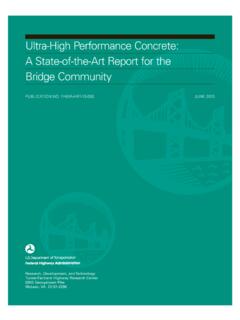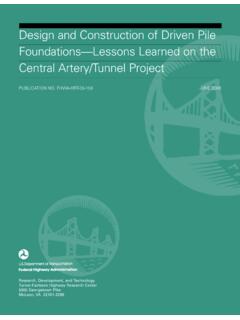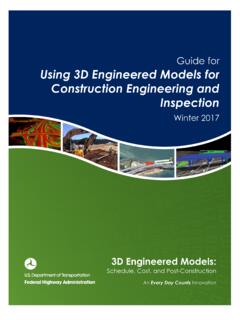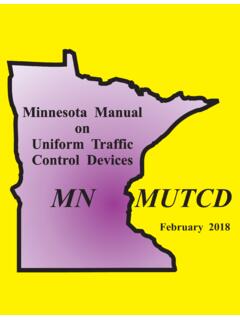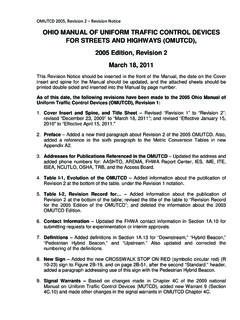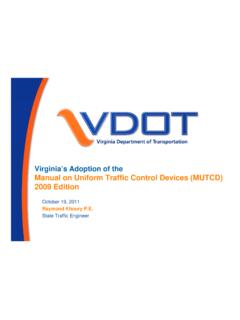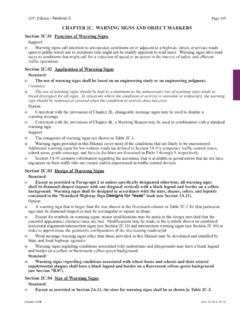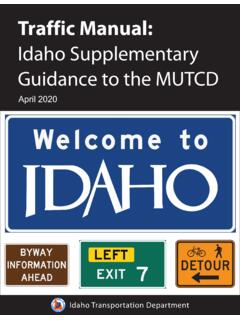Transcription of Traffic Design and Landscaping
1 183 Roundabouts: An Informational Guide 7: Traffic Design and Landscaping7. with the Manual on uniform Traffic signing and suburban signing signing considerations1957. 2 Pavement with the Manual on uniform Traffic and entry pavement roadway pavement pavement markings2017. for and recommended zone requirements2057. 4 Work Zone Traffic Designand Landscaping7 Federal Highway Administration184 Exhibit sign (R1-2).186 Exhibit WAY sign (R6-1R).186 Exhibit RIGHT sign (R4-7).186 Exhibit control signing for roundabouts with control signing for roundabouts with heavyturning Intersection sign (W2-6).189 Exhibit speed plate (W13-1).
2 189 Exhibit Ahead AHEAD sign (W3-2a).189 Exhibit Arrow sign (W1-6).190 Exhibit plate (W1-8a).190 Exhibit Crossing sign (W11-2a).190 Exhibit of advance destination guide guide sign (D1-1).192 Exhibit signing plan for an urban signing plan for a rural of speed reduction signing plan for a of yield pavement pavement marking plan for a of a street illumination of the central education2077. island island and approach 6 References209185 Roundabouts: An Informational Guide 7: Traffic Design and LandscapingThis chapter presents guidelines on the Design of Traffic elements, illumination,and Landscaping associated with roundabouts.
3 The Design of these elements iscritical in achieving the desired operational and safety features of a roundabout, aswell as the desired visibility and aesthetics. This chapter is divided into the follow-ing sections: Signing; Pavement Markings; Illumination; Work Zone Traffic control ; and SigningThe overall concept for roundabout signing is similar to general intersection sign-ing. Proper regulatory control , advance warning, and directional guidance are re-quired to avoid driver expectancy related problems. Signs should be located wherethey have maximum visibility for road users but a minimal likelihood of even mo-mentarily obscuring pedestrians as well as motorcyclists and bicyclists, who arethe most vulnerable of all roundabout users.
4 Signing needs are different for urbanand rural applications and for different categories of Relationship with the Manual on uniform Traffic control DevicesThe Manual on uniform Traffic control devices for Streets and Highways (MUTCD)(1) and Standard Highway Signs (2), as well as local applicable standards, governthe Design and placement of signs. To the extent possible, this guide has beenprepared in accordance with the 1988 edition of the MUTCD. However, round-abouts present a number of new signing issues that are not addressed in the 1988edition. For this reason, a number of new signs or uses for existing signs havebeen introduced that are under consideration for inclusion in the next edition of theMUTCD.
5 Until such signs or uses are formally adopted, these recommendationsshould be considered provisional and are subject to MUTCD Section 1A-6, ManualChanges, Interpretations and Authority to Experiment. The following signs and applications recommended below are subject to theseconditions: Use of YIELD signs on more than one approach to an intersection (Section ); Long chevron plate (Section ); Roundabout Ahead sign (Section ); Advance diagrammatic guide signs (Section ); and Exit guide signs (Section ).Signing, striping, illumination,and Landscaping are the criticalfinishing touches for aneffectively 7 Traffic Design and LandscapingFederal Highway Regulatory signsA number of regulatory signs are appropriate for roundabouts and are YIELD signA YIELD sign (R1-2), shown in Exhibit 7-1, is required at the entrance to the round-about.
6 For single-lane approaches, one YIELD sign placed on the right side is suffi-cient, although a second YIELD sign mounted in the splitter island on the left sideof the approach may be used. For approaches with more than one lane, the de-signer should place YIELD signs on both the left and right sides of the practice is consistent with the recommendations of the MUTCD on the loca-tion of STOP and YIELD signs on single-lane and multilane approaches (MUTCD, 2B-9). To prevent circulating vehicles from yielding unnecessarily, the face of theyield sign should not be visible from the circulatory roadway. YIELD signs may alsobe used at the entrance to crosswalks on both the entry and exit legs of an ap-proach.
7 However, the designer should not use both YIELD signs and PedestrianCrossing signs (see Section ) to mark a pedestrian crossing, as the yieldsigns at the roundabout entrance may be signs are required on KEEP RIGHT signKEEP RIGHT signs (R4-7 or text variations R4-7a and R4-7b) should be used at thenose of all nonmountable splitter islands. This sign is shown in Exhibit small splitter islands, a Type 1 object marker may be substituted for the KEEPRIGHT sign. This may reduce sign clutter and improve the visibility of the 7-1. YIELD sign (R1-2).Exhibit 7-2. ONE WAY sign(R6-1R).Exhibit 7-3. KEEP RIGHT sign(R4-7).ONE WAY signs establish thedirection of Traffic flow withinthe ONE WAY signONE WAY signs (R6-1R) may be used in the central island opposite the example is shown in Exhibit 7-2.
8 The ONE WAY sign may be supplemented withchevron signs to emphasize the direction of travel within the circulatory roadway(see Section ).At roundabouts with one-way streets on one or more approaches, the use of aregulatory ONE WAY sign may be confusing. In these cases, a Large Arrow warn-ing sign (see Section ) may be : An Informational Guide 7: Traffic Design and Lane-use control signsFor roundabouts with multiple entry lanes, it can often be confusing for unfamiliardrivers to know which lanes to use for the various left, through, and right move-ments. There is no international consensus on the effectiveness of lane-use signsand/or pavement designation of lanes on entry to a roundabout is directly related to a number offactors: Traffic volume balance.
9 Roundabouts with especially heavy left- or right-turningtraffic may require more than one lane to handle the expected demand (seeChapter 4). Exit lane requirements. In general, the number of exit lanes provided should bethe minimum required to handle the expected exit volume. This may not corre-spond with the number of entry lanes on the opposite side of the roundaboutthat would use the exit as through vehicles (see Chapter 4). The rules of the road. Drivers have a reasonable expectation that multiple throughlanes entering a roundabout will have an equal number of receiving lanes onexit on the far side of the roundabout (see Chapter 2).Lane-use control signs are generally not required where the number of receivinglanes for through vehicles on exit matches the number of entry lanes, as shown inExhibit 7-4.
10 Lane-use control signs should be used only for the following condi-tions: Where only a single exit lane is provided to receive two lanes of vehicles mak-ing through movements, lane-use designations should be made to indicate thatan entry lane drops as a turning movement (see Exhibit 7-4). This does not in-clude cases where an approach is flared from one to two lanes at the round-about. Where left- or right-turning Traffic demand dictates the need for more than oneleft-turn lane or more than one right-turn lane for capacity reasons (see Exhibit 7-5).The use of a left-turn-only lane designation as shown in the exhibits may be initiallyconfusing to drivers.




